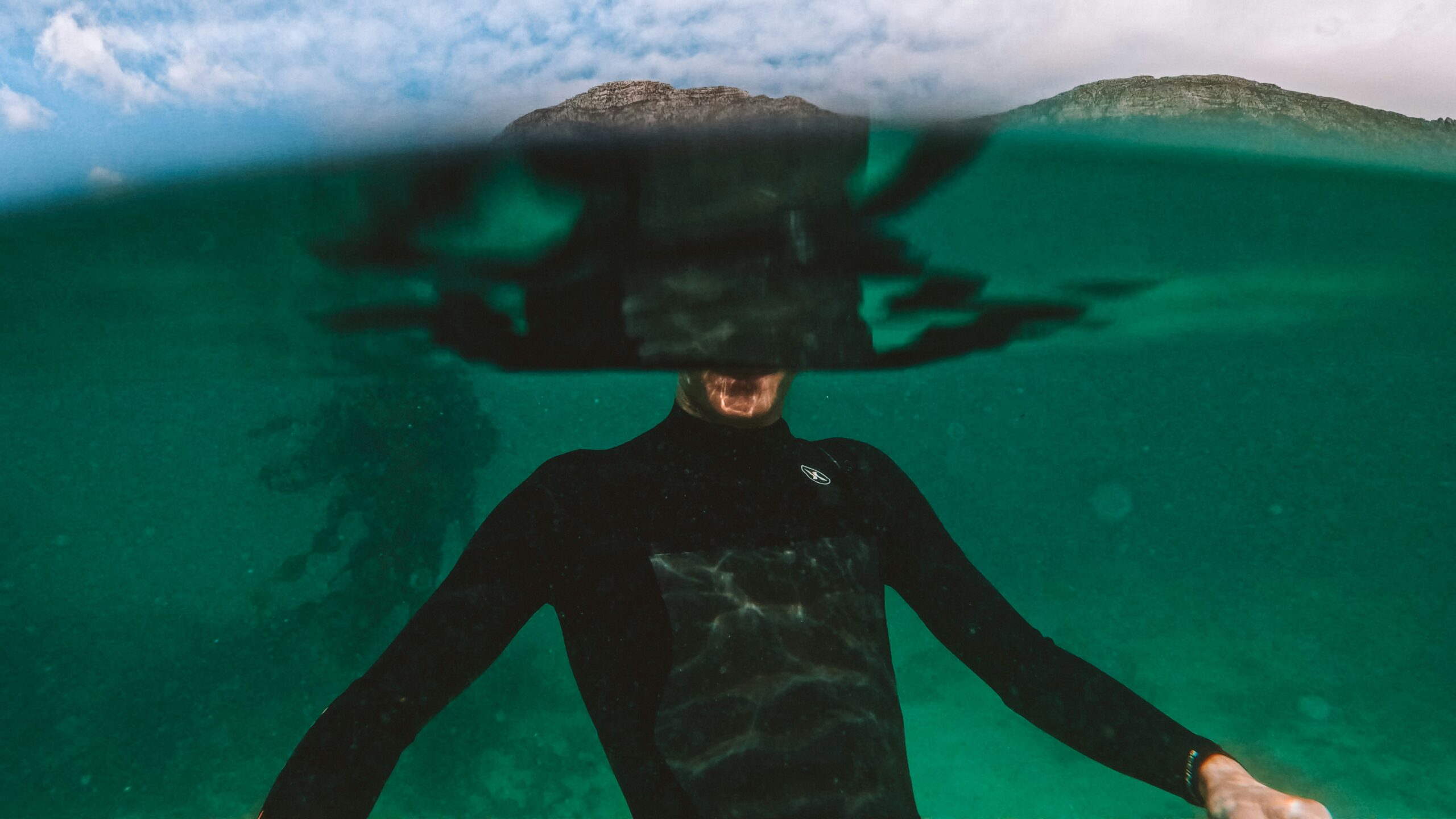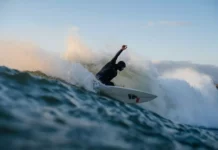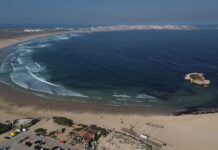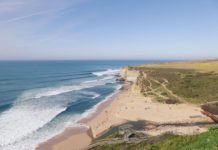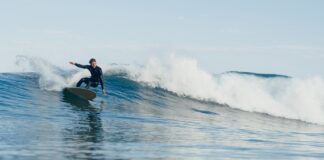Looking for the perfect wetsuit for your surf sessions in 2025? You’re in the right place. This guide is for surfers who care about quality, comfort, and sustainability. Whether you’re buying your first suit or upgrading to a high-performance model, we’ll help you make an informed decision.
We compared over 20 brands and dive into stretch, warmth, seam technology, and eco-innovations. Explore the world of modern wetsuits.
What You’ll Find on This Page:
- Recent Developments in Wetsuits (2020–2025)
- Types of Wetsuits
- Key Quality Factors to Consider
- Sustainable Materials vs. Traditional Neoprene
- Well-Known Wetsuit Brands in 2025
- New and Emerging Wetsuit Brands
- Entry-Level, Mid-Range & Premium Wetsuits
- Comparison Table by Brand
- Top 3 Wetsuit Picks for Men, Women & Kids
- Sources for This Wetsuit Research
Quick summary for busy readers that need to get into the water
In 2025, top wetsuits stand out for their combination of ultra-flexible materials (like Yamamoto limestone neoprene or Technobutter 4), thermal linings (such as Graphene or Celliant), and fully sealed seams with liquid or taped finishes. Eco-friendly alternatives like Yulex (natural rubber) are on the rise, matching performance standards without compromising sustainability.
Leading brands include Rip Curl, O’Neill, Billabong, Xcel, and Patagonia, while innovators like SRFACE, Need Essentials, Wildsuits, and Deeply are shaking up the market with affordable high-tech options. Our personal favorite? The SRFACE Remix 4/3mm — a premium-level wetsuit at a fair price.
Top 3 wetsuit picks for men, women & kids
Men:
1. Billabong Furnace Natural – Excellent combination of eco materials and warmth with graphene lining.
2. O’Neill Hyperfreak – High performance with Technobutter 4 neoprene and minimal seams.
3. SRFACE Remix – Outstanding value, great all-rounder for serious cold-water surfers.
Women:
1. Patagonia R2 Yulex – Fully neoprene-free, warm, and built to last — ideal for eco-conscious surfers.
2. Roxy Syncro – Affordable, well-designed women’s wetsuit with solid GBS seams and good warmth.
3. SRFACE Heat – High-quality suit with thermal lining and excellent fit at a competitive price.
Kids:
1. O’Neill Youth Epic – Durable and warm suit, great for extended water time.
2. Olaian Shorty for summer (2/2)– Perfect entry-level summer suit for casual beach days.
3. Rip Curl Dawn Patrol Youth for winter (5mm)– Reliable winter wetsuit for ambitious young surfers.
Scroll down for the full guide or use the menu above to jump straight to the section that interests you most.
Recent developments in wetsuits (2020–2025)
The past five years have seen major leaps in wetsuit innovation. Sustainability is now a central focus. Brands like Patagonia and Picture Organic are leading the way with natural rubber (Yulex) and recycled materials that aim to replace traditional neoprene. Others, like Billabong, have followed with eco-conscious lines. High-performance materials such as Yamamoto limestone neoprene and graphene-infused linings make wetsuits warmer and more flexible than ever. Seamless construction, improved seals, and zip-free designs are also gaining popularity for enhanced comfort and mobility.
Types of wetsuits
There are several common wetsuit styles: fullsuits (long arms and legs, ideal for cold water), springsuits (shorter arms or legs for warmer conditions), long johns, and wetsuit tops. The right choice depends on water temperature, the season, and your surf style. A 4/3mm or 5/4mm fullsuit is best for autumn to winter, while a 2mm shorty is perfect for summer. Hooded suits are designed for freezing temperatures. Many brands also offer gender-specific cuts and youth sizes.
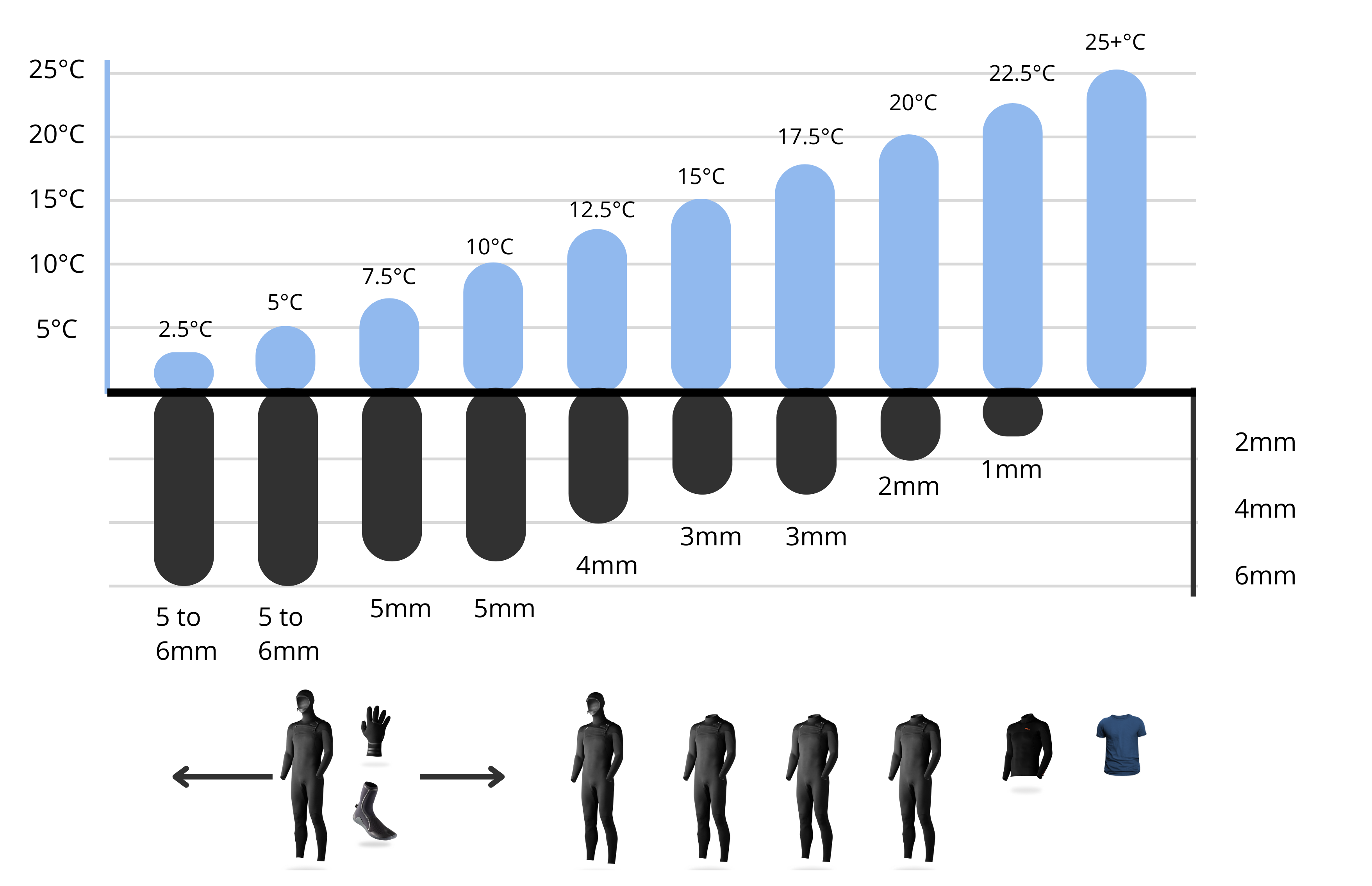
Key quality factors to consider
Flexibility: High-end wetsuits use premium materials like Yamamoto neoprene or Technobutter 4, which stretch easily without losing shape.
Seams: Entry-level wetsuits often use flatlock stitching, which is less water-resistant. Mid to high-end models use glued and blind-stitched (GBS) seams, often with internal taping or liquid sealing for extra warmth.
Thickness: Choose 3/2mm for summer, 4/3mm for spring and autumn, and 5/4mm or thicker for winter conditions.
Fit & Comfort: A wetsuit should fit snugly but not restrict movement. Look for anatomical panels and minimal seam construction for better flexibility.
Lining: Thermal linings like fleece, graphene, or Celliant retain heat and speed up drying time, improving comfort in colder sessions.
Well-Known wetsuit brands in 2025
Patagonia: Known for their outdoor apparel, Patagonia has been a wetsuit player since the early 2000s with a strong focus on sustainability. They shook the market by abandoning neoprene entirely — all their wetsuits are now made from Yulex natural rubber. Models are labeled R1, R2, R3, R4 depending on water temperature needs. The R4 Yulex, for example, is a thick winter wetsuit made for frigid conditions. Their construction is impressive: triple glued, blind-stitched, and fully taped seams. Some older models even had external taping, though newer versions removed it to improve flexibility.
O’Neill: The inventor of the wetsuit and still a global leader. The Hyperfreak series is beloved for its extreme comfort, powered by Technobutter 3 or 4 — some of the stretchiest neoprene around. O’Neill leans into performance more than eco credentials, although their Blueprint series is more eco-conscious. Solid value, wide range for men, women, and kids.
Rip Curl: This Australian brand pushes innovation with suits like the Flashbomb Heatseeker and E-Bomb, known for their fast-drying flash lining and E7 neoprene. Ideal for surfers who want to surf multiple sessions per day. Rip Curl also offers an Eco line with recycled linings and water-based adhesives.
Billabong: Blends progressive technology like Graphene lining with sustainability. The Furnace Natural model is fully neoprene-free, using Yulex, recycled interiors, and solvent-free glue. With stylish cuts and bold designs, it remains popular among younger surfers.
SRFACE: A direct-to-consumer brand from the Netherlands and Belgium, offering premium Japanese limestone neoprene at competitive prices. The SRFACE Remix is a top performer loved by experienced surfers. Their sizing tool and eco-options make them a smart, transparent brand.
Xcel: A Hawaii-based company known for warm, winter-ready suits. Their TDC lining and Drylock tech make them a favorite in colder regions. They focus less on eco-marketing and more on technical thermal performance.
Picture Organic: A French brand that focuses heavily on environmentally responsible production. Their wetsuits use Eicoprene (a limestone + natural oil blend) instead of neoprene, with solvent-free glue and recycled lining. Their aesthetic is bold and modern — you can tell it’s not just another surf brand.
New and emerging wetsuit brands
Wildsuits (France): An eco-driven brand using recycled materials and limestone neoprene. Designed in France and manufactured in Morocco, Wildsuits offers good warmth and flexibility at a fair price. They’re quickly gaining traction in the European market with a strong community feel.
Deeply (Portugal): Known for stylish and affordable wetsuits that integrate modern tech like graphene linings. Deeply’s products combine good stretch, warmth, and smart cuts — ideal for both beginners and seasoned surfers on a budget.
Soöruz (France): Pioneers in Naturalprene (made from rubber tree latex), algae-based foams, and bio-sourced glues. Soöruz continues to push the envelope in sustainable surf gear, including wetsuits designed for cold-water performance with a green conscience.
Manera (France): Focused on ergonomic fit and long-lasting durability, Manera’s suits are designed using 3D modeling to maximize comfort and freedom of movement. Though not always eco-labeled, the brand is known for quality and innovation.
Need Essentials (Australia): Offers minimalist, unbranded wetsuits at a fraction of the usual price by cutting out retail markups. The focus is on performance, warmth, and durability, with fewer aesthetic frills — great value for core surfers.
Vissla (USA): Surfing with soul — Vissla’s eco-conscious wetsuits use limestone neoprene, Dope Dyed yarns, and recycled linings. They offer progressive styling and solid tech for surfers who care about performance and the planet.
SRFACE (NL/BE): Though already mentioned among big brands, their fresh take on direct-to-consumer innovation and eco-packaging still places them among standout new brands shaping the wetsuit landscape.
Sustainable materials vs. traditional neoprene
Yulex: A plant-based natural rubber that has become the benchmark for eco-friendly wetsuits. Brands like Patagonia have adopted Yulex across their entire wetsuit line. It performs almost identically to traditional neoprene in terms of flexibility and warmth, but with a significantly reduced environmental footprint.
Limestone Neoprene: Mined from limestone rock, this version is more durable and water-resistant than petroleum-based neoprene. Though not renewable, it’s considered a less harmful option and widely used in high-end wetsuits from brands like SRFACE, Xcel, and O’Neill.
Recycled Linings & Solvent-Free Glues: Many brands now use recycled polyester (from plastic bottles) in inner linings and switch to water-based or solvent-free glues, further reducing chemical impact.
Naturalprene, Ecoprene & Others: Smaller brands such as Soöruz and Picture Organic explore even newer materials like algae-based foams or Naturalprene (a renewable rubber compound) in their most eco-advanced suits.
Overall, sustainable wetsuits are no longer a compromise. In 2025, they offer top-tier performance while helping reduce the environmental cost of surfing.
Entry-level, mid-range & premium Wetsuits
Entry-Level: These are the most budget-friendly wetsuits, ideal for beginners, casual surfers, or as a backup summer suit. Entry-level suits (typically €50–€150) use standard neoprene that has less stretch. Seams are often flatlock or basic glued-blind-stitched without tape. You won’t get plush linings—just basic nylon jersey interiors. Examples: O’Neill Reactor II, Rip Curl Omega, Quiksilver Prologue, Billabong Absolute 3/2. Perfect for warm conditions or short sessions. Pros: Low price, gets the job done. Cons: Less flexible and warm, shorter lifespan (2 seasons with heavy use), and less water resistance.
Mid-Range: In this tier (€150–€300), you get a major upgrade in performance. These suits typically feature GBS seams and some taping or liquid sealing in stress areas. Neoprene is higher quality (like Superstretch or Limestone), offering significantly better flexibility. You’ll often see thermal panels on the chest and back. Suited for most conditions faced by average surfers. Examples: Rip Curl Dawn Patrol, Xcel Comp, O’Neill Hyperfreak (non-Firewall), Billabong Furnace Absolute. Pros: Excellent value — noticeable improvement in warmth and comfort. Cons: Not top-tier materials, pros will notice differences. Some luxury features may be missing (like full taping or ultra-lightweight foam).
Premium: This is the high-performance tier (€300–€600+). These are flagship suits loaded with cutting-edge tech: ultra-stretch Japanese neoprene, fully taped or welded seams, unique linings throughout, 3D anatomical paneling, and zipperless designs. Examples: Patagonia R4 Yulex, Rip Curl Flashbomb Heatseeker, O’Neill Psychotech / Hyperfreak Fire, Xcel Drylock, Billabong Furnace Natural, SRFACE Remix. Even thick 5/4 hooded suits in this category feel surprisingly light and stretchy. Pros: Maximum comfort (feels like a second skin) and ideal for long sessions in cold water. Cons: Expensive. Requires proper care (rinsing, drying flat). High-tech materials can be more fragile, but when treated well, premium suits last multiple heavy-use seasons.
Comparison table by brand
| Brand | Flexibility | Warmth | Seams & Finish | Sustainability | Top Models |
|---|---|---|---|---|---|
| O’Neill | Very high (Technobutter 4) | High (Firewall lining) | GBS + taping, zipless options | Good (Blueprint series) | Hyperfreak, Psycho Tech |
| Rip Curl | Very high (E7 neoprene) | Very high (Flash lining) | GBS + liquid seal | Moderate (recycled lining) | Flashbomb, E-Bomb |
| Patagonia | High (Yulex, improved) | Very high (merino/thermal lining) | Triple GBS + full tape | Excellent (100% neoprene-free) | R2, R3, R4 |
| SRFACE | Very high (Yamamoto) | High (Thermal lining) | GBS + taped critical seams | Good (eco option) | Remix, Heat |
| Billabong | High (Airlite foam) | Very high (Graphene lining) | GBS + internal tape | Excellent (Furnace Natural) | Furnace, Absolute |
| Xcel | High (Nanoprene Lite) | Very high (TDC lining) | Full tape + Drylock seals | Good (limestone neoprene) | Drylock, Comp |
| Decathlon | Basic (entry neoprene) | Basic (no lining) | Flatlock / basic GBS | Improving (recycled elements) | Olaian 100, 500, 900 |
Top 3 wetsuit picks for men, women & kids
Men:
1. Billabong Furnace Natural – Excellent combination of eco materials and warmth with graphene lining.
2. O’Neill Hyperfreak – High performance with Technobutter 4 neoprene and minimal seams.
3. SRFACE Remix – Outstanding value, great all-rounder for serious cold-water surfers.
Women:
1. Patagonia R2 Yulex – Fully neoprene-free, warm, and built to last — ideal for eco-conscious surfers.
2. Roxy Syncro – Affordable, well-designed women’s wetsuit with solid GBS seams and good warmth.
3. SRFACE Heat – High-quality suit with thermal lining and excellent fit at a competitive price.
Kids:
1. O’Neill Youth Epic – Durable and warm suit, great for extended water time.
2. Olaian Shorty for summer (2/2)– Perfect entry-level summer suit for casual beach days.
3. Rip Curl Dawn Patrol Youth for winter (5mm)– Reliable winter wetsuit for ambitious young surfers.
Sources for this wetsuit research:
-
Product information and specifications from Rip Curl, O’Neill, Billabong, Patagonia, Xcel, SRFACE, C-Skins, Need Essentials, Picture Organic
-
Updates on wetsuit innovations from 2020–2025 via Surfline, Stab Magazine, and The Inertia
-
Brand pages and technical manuals from Yulex, Yamamoto, NaturalPrene, Limestone Rubber
-
User reviews from the Boardshortz community, Reddit r/surfing, YouTube gear reviewers, and surf shops such as SurfDome, Euroglass, Decathlon, and Surfd.nl
-
Personal usage experience.

